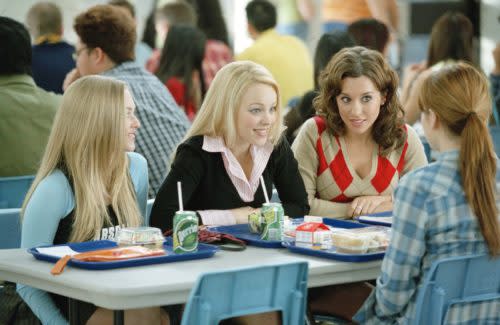The moment I learned that I didn’t want to compete with other girls — despite what my friends expected

September 17th was National Women’s Friendship Day. For the entire month, we are sharing stories that examine the unique role that friendship plays in women’s lives.
I began elementary school at a private school, wearing uniforms and hanging out with a tight-knit friend group. We’d all known each other since kindergarten and our school cliques were very low-key — I got along with just about everyone. Plus, since we wore uniforms, we were all on an equal playing field — no one could be mocked for their clothing or for what outfits they could afford.
But at the beginning of fourth grade, my dad suggested that we visit a public elementary school closer to our house. Gone were the school uniforms, saddle shoes, and mandatory Mass. The students seemed chattier and the teachers seemed to be having more fun. If I had to pick a word for the school’s vibe during my visit, it would be “chill.” I immediately wanted to switch schools — I knew I’d miss my private school friends, but I could still hang out with them whenever I wanted.
On my first day there, I was greeted by three girls who quickly became my closest friends.
It was surreal how it all happened. They heard I was the new kid, and quickly approached me as I walked to class. Wearing their Roxy halter tops, Limited Too bell bottoms and matching jean jackets, they also happened to be the most stylish fourth graders I’d ever seen.
I felt severely underdressed.
“Hi! You must be Alex,” Courtney said energetically in her SoCal Valley Girl tone. She was tall and skinny with long blonde hair, a mini-Paris Hilton reincarnated. Joined by her friends, Jessica and Nicole, they circled around me as they introduced themselves. Jessica and Nicole were clearly Courtney’s “sidekicks,” but they had hair just as voluminous and could have easily passed for stars of a Disney Channel original movie. They were all pretty, outgoing, and nice.
Though I was unsure of how I’d navigate my new public school journey, I felt reassured when the trio promised to show me around the school. All my insecurities about being the new girl vanished in minutes. I knew that I’d be able to go home at the end of the day and tell my dad that I’d made friends.
But like the story of Cady Heron in Mean Girls, I too was fresh meat.
Within days, I became a part of their inner circle. They told me about the cute boys at school, Eric and Matt, and explained that these guys were my only two options for crushes. I was confused by this rule — but I decided to have a crush on Matt. He was also good at reading and seemed less rebellious than Eric.
It may have only been fourth grade, but elementary school politics controlled our lives, from where we sat during lunch to which kids we couldn’t hang out with. Everything was calculated.
While I felt supported by my new friend group, some things in our daily routine seemed…off.
Let’s talk about lunch. You were supposed to wait in a long line to enter the lunch quad, so most kids lined up in an orderly fashion — but not us. No, in our clique, we got to go to the very front of the line. I guessed that we somehow had privileges that I didn’t understand, allowing us to cut in front of everyone else. I thought it was strange that we broke the rules, but I never questioned it. I thought, maybe this was just how the school worked — plus, I wasn’t going to complain about being first in line.
We had a designated lunch spot, which was questionable considering that all the other students sat at random tables in the lunch quad. Meanwhile, we had dibs on a corner of the quad where we gathered on the ground. It felt very cult-like and strange to me — if we were going to have a specified lunch spot, why would it be on the ground?
But, mostly, lunch was when gossip was dished, rumors were spread, and allegiances were revealed.
Our lunch time discussions only included talking badly about other girls in our school. Sometimes we swapped rumors about less popular girls who had kissed nerdy boys behind the swings.
“Can you believe she wore that?” one would say while we all laughed in unison.
The entire time, though, I felt uncomfortable with these conversations. I had no gossip to contribute, nor did I want to contribute. But I didn’t yet understand why I was so unsettled by our lunches together. Months later, over sack lunches, Jessica called me out in front of Courtney and Nicole:
“Alex, why are you so quiet during lunch?”
In that moment, I realized I had nothing in common with my so-called friends. I didn’t want to be friends with these girls who only tore other girls down.
After that confrontation, I slowly drifted away from the coveted lunch clique. There wasn’t any dramatic friend breakup. I just started hanging out with different girls — girls who didn’t cut in front of the line or mock our classmates. I ended up meeting my best friend when we both stumbled upon a dead rat in the girl’s bathroom — it was both traumatic and hilarious. I finally figured out that bonding over genuine and interesting experiences was more fun than repeating cruel gossip.
Though my brush with the popular girls was short, it left a mark on me. It helped me carve out my own path separate from the girl-on-girl hate we’re conditioned to accept as normal. It helped me form friendships with girls — and later, women — in which we truly understand and support each other.

